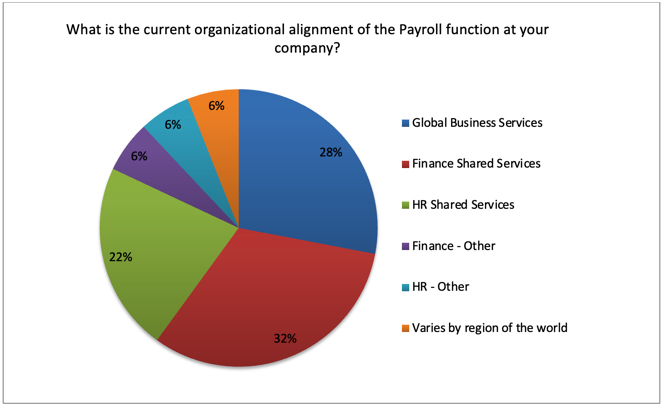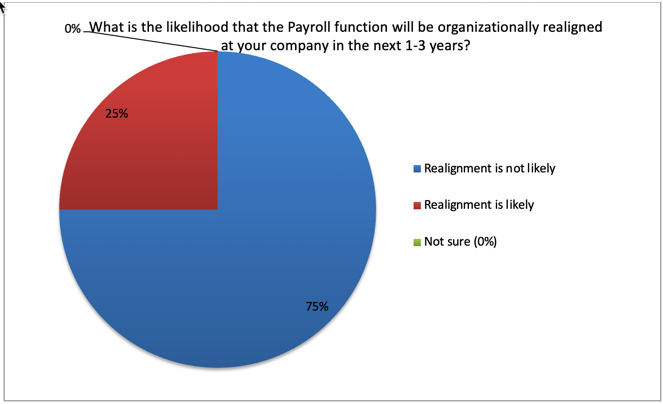Alignment of the Payroll Process – Finance or HR?
Introduction
Historically, the alignment of the Payroll function has been debated between HR and Finance as to where it belongs. Some argue that synergies with HR provide for the best fit, and others state that Payroll is a Finance function because of all the accounting-related transactional complexities.
The growth of Shared Services and Global Business Services models have yet to completely settle the debate. While Shared Services is founded on the principles of enjoying the benefits of centralization and scale yet remaining flexible as an internal business, delivering services broadly to a company with multiple business units that are often distributed around the world. Moving the delivery of back-office processes to a new type of organization focused on continuous improvement and customer satisfaction; an organization that is independent of the segment of the company being serviced is a significant change that creates greater value for the company at a cost savings of 50% or more. In many cases, functional boundaries are challenged, which can increase opportunities to leverage process change techniques and new technologies by eliminating turf battles that are all too common between functions or departments.
While these new types of Shared Services delivery organizations may change their names to Global Business Services or Global Integrated Services, as they evolve to where the identity of processes managed are considered “Shared Services” more strongly than “Finance” or “HR”, the ability to achieve even more impactful results becomes a new possibility, with a higher probability of a true redesign of end-to-end processes at a detail level.
As a word of caution, not every organization that has attempted to implement Shared Services has been successful, and achieving the elimination of functional identity for work processes delivered by a Shared Services or Global Business Services organization is even more challenging. A key to success is being intimately aware of the culture of your company, so you have insight into where taking the risk of organizational change will most likely meet with success. Finally, there is no “we have arrived” moment, with change opportunities certain to increase as your Shared Services model is proven to be successful.
iPolling Results Review
Peeriosity’s iPolling was used to learn more about the current organizational alignment of the Payroll function at Peeriosity member companies. The poll results clearly demonstrate the impact of Shared Services and Global Business Services on the issue, with 28% of Peeriosity member companies having Payroll aligned to Global Business Services, with an additional 54% having Payroll aligned to Shared Services. When identified as a specific organization within Shared Services, 32% have Payroll reporting to Finance Shared Services and 22% have Payroll reporting to HR Shared Services. While the differentiation between Finance and HR Shared Services can be significant, the Shared Services approach is fundamentally different than functional alignment, with communication and leverage between Share Services organizations likely to occur, and with these organizations often reporting to a common senior executive.

To complete the picture, 12% of Peeriosity member companies have Payroll aligned directly to either Finance or HR, with an additional 6% that have differences based on the region of the world served.

The iPoll also asked about the likelihood that the Payroll function will be organizationally realigned by Peeriosity member companies within the next one to three years. 75% indicated that realignment is not likely with 25% reporting that realignment is likely to occur. Again, as stated above, this issue is more nuanced than a yes or no answer might suggest, with companies who have Payroll in Shared Services being better positioned to reduce the negative impact of functional boundaries.
Here are some of the comments from members:
- Current company – HR Shared Services and it works well. At my previous company, Payroll was under Finance Shared Services to oversee the large disbursements and streamline processes. We worked very closely with HR and took direction from them on strategy and policies.
- In the US, Payroll is aligned with Finance. Outside the US, Payroll is aligned with HR.
- Regarding the comment that it is aligned with the Finance function because it impacts the GL, I would also stress that the complexities and requirements of Payroll Tax as well as the need for robust controls align more with Finance than HR.
- Payroll officially moved into HR shared services within the past year, eager to learn how others are structured.
- We recently realigned and moved Payroll from Finance to HR OPs/Shared Service.
Closing Summary
For many years the functional alignment of the Payroll functions a been a toss-up between Finance and HR. The process requires significant analytical skills that are accounting-focused, yet the nature of the underlying process is related to employees, which clearly suggests a strong connection to HR. With the growth of Shared Services and Business Services models the functional alignment has been reduced or eliminated, creating greater opportunities for companies to leverage process designs and technologies broadly without the constraints that functional boundaries can create.
What is the current organizational alignment of the Payroll function at your company? What is the likelihood that a realignment will take place within the next 1 to 3 years?
Who are your peers and how are you collaborating with them?
________________________________________________________________________________________________
“iPollingTM” is available exclusively to Peeriosity member company employees, with consultants or vendors prohibited from participating or accessing content. Members have full visibility of all respondents and their comments. Using Peeriosity’s integrated email system, Peer MailTM, members can easily communicate at any time with others who participated in iPolling.
Peeriosity members are invited to log into www.peeriosity.com to join the discussion and connect with Peers. Membership is for practitioners only, with no consultants or vendors permitted. To learn more about Peeriosity, click here.

